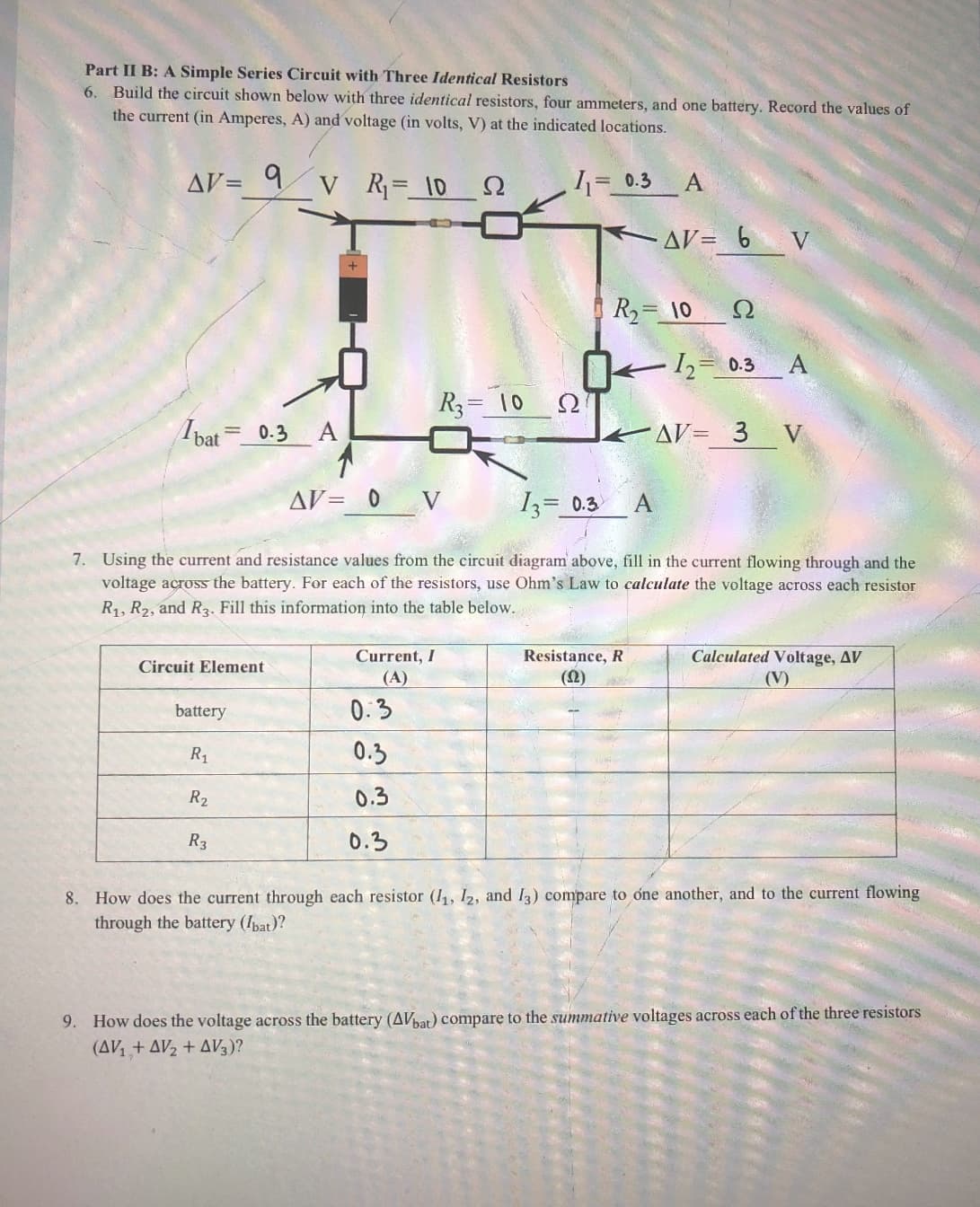Part II B: A Simple Series Circuit with Three Identical Resistors Build the circuit shown below with three identical resistors, four ammeters, and one battery. Record the values of the current (in Amperes, A) and voltage (in volts, V) at the indicated locations. 6. AV= 9 v R= 102 1= 0.3 RAV= 6 V R 10 2 K2= 0.3 A R3= 10 Ibat= 0.3 A KAV= 3 V AV= 0 V 13= 0.3 7. Using the current and resistance values from the circuit diagram above, fill in the current flowing through and the voltage across the battery. For each of the resistors, use Ohm's Law to calculate the voltage across each resistor R1, R2, and R3. Fill this information into the table below. Current, I Calculated Voltage, AV Resistance, R (2) Circuit Element (A) (V) battery 0.3 R1 0.3 R2 0.3 R3 0.3 8. How does the current through each resistor (I, 12, and I3) compare to one another, and to the current flowing through the battery (Ipat)? 9. How does the voltage across the battery (AVat) compare to the summative voltages across each of the three resistors (AV1 + AV2 + AV3)?
Part II B: A Simple Series Circuit with Three Identical Resistors Build the circuit shown below with three identical resistors, four ammeters, and one battery. Record the values of the current (in Amperes, A) and voltage (in volts, V) at the indicated locations. 6. AV= 9 v R= 102 1= 0.3 RAV= 6 V R 10 2 K2= 0.3 A R3= 10 Ibat= 0.3 A KAV= 3 V AV= 0 V 13= 0.3 7. Using the current and resistance values from the circuit diagram above, fill in the current flowing through and the voltage across the battery. For each of the resistors, use Ohm's Law to calculate the voltage across each resistor R1, R2, and R3. Fill this information into the table below. Current, I Calculated Voltage, AV Resistance, R (2) Circuit Element (A) (V) battery 0.3 R1 0.3 R2 0.3 R3 0.3 8. How does the current through each resistor (I, 12, and I3) compare to one another, and to the current flowing through the battery (Ipat)? 9. How does the voltage across the battery (AVat) compare to the summative voltages across each of the three resistors (AV1 + AV2 + AV3)?
Delmar's Standard Textbook Of Electricity
7th Edition
ISBN:9781337900348
Author:Stephen L. Herman
Publisher:Stephen L. Herman
Chapter2: Electrical Quantities And Ohm’s Law
Section: Chapter Questions
Problem 1PA: You are an electrician on the job. The electrical blueprint shows that eight 500-W lamps are to be...
Related questions
Question

Transcribed Image Text:Part II B: A Simple Series Circuit with Three Identical Resistors
6. Build the circuit shown below with three identical resistors, four ammeters, and one battery. Record the values of
the current (in Amperes, A) and voltage (in volts, V) at the indicated locations.
AV= 9
V R= 10 2
= 0.3
A
- AV= 6 V
R2= 10
K2= 0.3
R3= 10
Ipat=0.3
A
KAV= 3 V
AV= 0 V
13= 0.3
7. Using the current and resistance values from the circuit diagram above, fill in the current flowing through and the
voltage across the battery. For each of the resistors, use Ohm's Law to calculate the voltage across each resistor
R, R2, and R3. Fill this information into the table below.
Calculated Voltage, AV
(V)
Current, I
Resistance, R
(Q)
Circuit Element
(A)
battery
0.3
R1
0.3
R2
0.3
R3
0.3
8.
How does the current through each resistor (I, I2, and 13) compare to one another, and to the current flowing
through the battery (Ibat)?
9. How does the voltage across the battery (AVhat) compare to the summative voltages across each of the three resistors
(AV + AV2 + AV3)?
Expert Solution
Step 1
Current is said to flow in a closed circuit when a potential is applied across the ends of a resistor. A resistor is an electrical element that provides means of obstruction to the path of current. The phenomenon is called resistance. The relation between resistance, current and voltage is given by the equation V=I*R known as Ohm's Law.
Trending now
This is a popular solution!
Step by step
Solved in 2 steps with 1 images

Knowledge Booster
Learn more about
Need a deep-dive on the concept behind this application? Look no further. Learn more about this topic, electrical-engineering and related others by exploring similar questions and additional content below.Recommended textbooks for you

Delmar's Standard Textbook Of Electricity
Electrical Engineering
ISBN:
9781337900348
Author:
Stephen L. Herman
Publisher:
Cengage Learning

Delmar's Standard Textbook Of Electricity
Electrical Engineering
ISBN:
9781337900348
Author:
Stephen L. Herman
Publisher:
Cengage Learning